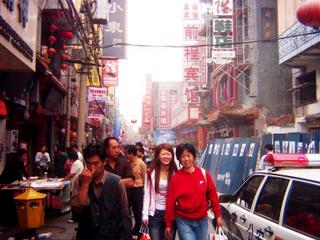Life in Harbin

Harbin is in the North East of China, in what used to be called Manchuria.
I remember learning about Manchuria when I was a kid collecting stamps. I had a few from Manchuria and it seemed to be the most distant place I could imagine. Now, I find myself living here. So it's still a bit of a shock. Here's some info on it:
Harbin (här'bĭn) , (Rus. Kharbin), on the Songhua River, population 2,505,200, (1994) is the capital of Heilongjiang province in NE China .
It is the major trade and communications center of central Manchuria, sitting at the junction of the two most important railroads in Manchuria, and the main port on the Songhua.
Part of the great Manchurian industrial complex of metallurgical, machinery, chemical, petroleum, and coal industries, Harbin also has railroad shops, food-processing establishments (soybeans are a major commodity), and plants making tractors, turbines, boilers, precision instruments, electrical and electronic equipment, cement, and fertilizer.
Harbin was unimportant until Russia was granted a concession (1896) and built a modern section alongside the old Chinese town. (Russia surrendered its concession in 1924.) Flooded by White Russian refugees after 1917, Harbin had one of the largest European populations in East Asia. Most of the Europeans left the city following the rise to power of the Chinese Communists.

It used to be called the "Paris of the Orient" in the early 20th century and was full of Europeans wanting to enjoy the combination of European savoir faire and oriental mystique. There is still a large Russian presence, as indicated by the church of St. Sophia, (above) and the distinctively Russian architecture bordering the large pedestrian mall in the centre of town. (left)
There is a lot of interesting architecture in Harbin, both classical and modern.
A view from the top observation platform on the Dragon Tower, the tallest structure in Harbin, reveals not only apartment complexes as far as the eye can see, but also some beautiful, modern buildings.

Walking down the street, one is confronted with an amazing variety of goings-on. On the one hand, there are the broad thoroughfares, twelve lanes wide, with scores of busses competing for space with all manner of trucks, cars, motorcycles, pedestrians and people on bicycles, all trying to make their way to their destinations, no matter who or what blocks their way.
There seems to be no right of way in Harbin. An old man on a rickety bicycle will insist on being allowed to drive down or to cross
 the street in whatever direction he chooses, regardless of other drivers, other people on foot, or whether the light is red or green.
the street in whatever direction he chooses, regardless of other drivers, other people on foot, or whether the light is red or green.You'll see people driving down the street against the flow of traffic, completely oblivious to the fact that (at least, to this westerner's eyes) they are going the wrong way!
On the other hand, turning a corner from a main street, you'll suddenly find yourself in a narrow
alley where there seems to be a whole other level of society carrying on their business. There are tiny shops, rows of women tryi
 ng to entice you to get your shoes shined, sidewalk vendors selling anything and everything you can imagine, people cooking and selling meat barbequed over charcoal in barrels or home-made metal troughs, and people unloading live crabs or dead fish from trucks onto the sidewalk, where they hold up a particularly unappealing specimine for you to examine as you walk by.
ng to entice you to get your shoes shined, sidewalk vendors selling anything and everything you can imagine, people cooking and selling meat barbequed over charcoal in barrels or home-made metal troughs, and people unloading live crabs or dead fish from trucks onto the sidewalk, where they hold up a particularly unappealing specimine for you to examine as you walk by.In Harbin, every trip outside my apartment is an adventure.


